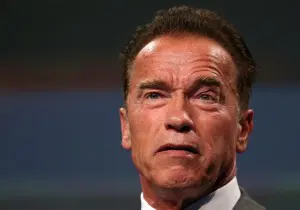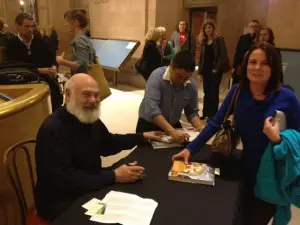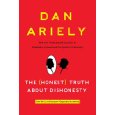The Wisdom 2.0 Bottom Line
March 2, 2015
I spent the last few days at the annual Wisdom 2.0 conference in San Francisco.
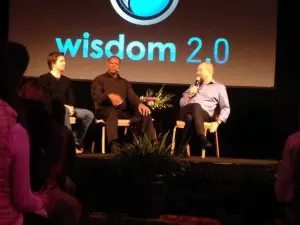
Michael Gervais, (left) George Mumford and Mike Robbins (right) discuss sports and psychology and the Wisdom 2.0 conference in San Francisco February 28, 2015,
Many of you have probably never heard of the event, so a little context is probably in order.
Attendance this year reached 2500 and could have gone higher if organizers had not capped it. The conference is designed as a combination celebration and support group for anyone trying to bring more: (pick one) consciousness, gratitude, or mindfulness to technology and business.
Attendees come from all over the world, although a large percentage are from California, to hear a variety of speakers from CEO’s to human resource managers, explain how they have tried to humanize their companies and deal with the increasing demands of the ‘always on’ world.
Using mindful meditation, exhortations to be present, and a wide variety of what many might consider alternative techniques, the conference is in direct contrast to the prevailing view of corporate America as a ruthless, cut throat, bottom line, profit driven culture.
In addition to the conference presentations on everything from neuroscience to networking, there are rooms devoted to meditation, and yoga, as well as a trade show in the Inspiration Lounge.
Many sessions focus on how to live a more fulfilling and compassionate life and to make choices that leave you happier both personally and in your career.
Here you can also find the latest in relaxation and stress reduction equipment and techniques.
While you might think the principles were some import from Europe, most of the foreign attendees, are quick to note that the techniques are uniquely American, which is what draws them here.
Companies with representative include LinkedIn, Facebook, Twitter, Google, Gap and a host of others who say that recent studies have shown conclusively that promoting mindfulness and self realization in their workforce actually adds to their bottom line in quantifiable manner.
In reality the conference is a large networking event, where like-minded folks can get together to reinforce their beliefs in hopes of connecting with someone who can help them move forward in their career.
A large percentage of the attendees are personal/executive coaches or management consultants, who are looking to make connections with those HR types from Google, Twitter, Facebook and GAP, to improve workplace performance. Admittedly the chances are slim, but you never know.
In two days I collected a raft of business cards, and spoke with lawyers, coaches, HR managers and some old friends from the spa and yoga worlds.
My wife, who is a clinical psychologist, and attended the first Wisdom conference 6 years ago, may be a more typical participant, but she was ill over the weekend and insisted I attend.
I’ll admit I was hesitant, but after three days I was pleasantly surprised and happy I made the effort. More on some of the things I learned will come in subsequent posts.
When organizers at the opening session asked who, in the audience, was a first-time attendee, I raised my hand along with two-thirds of the crowd.
Sponsors were thrilled, saying it showed how the movement was attracting new members. But you have to think; what does it mean when attendees at previous sessions are not coming back in significant numbers?
If this were a business that had to rely on new customers for 66% of it’s profit each year, would you be optimistic?
Would You Reprint Charlie Hebdo’s Cartoons?
January 13, 2015
Ever since the attack on Charlie Hebdo last week I’ve been wondering what I would have done if I were still an editor at a newspaper.
The day after the attack, I was consumed with embarrassment for my profession when so few papers, who reported the murders, printed any of the offending cartoons.
As part of their coverage some publications in Europe did print a cartoon, but except for the Washington Post, I’m not aware of any major US publications who printed an example.
Even the Post printed the cartoon on the editorial page leaving the news columns free to describe the artwork. They, like the New York Times and other publications, claimed the actual drawing ‘were not relevant’ and their message could be communicated in words.
Clearly the cartoons were relevant, and just as clearly, mere words could not describe why the cartoons led to the attack. In truth, after looking at a sampling of the cartoons, I found many childish, insulting and tasteless, but I would still defend their right to publish them.
Almost every religion came under attack, but according to some, only the Muslim faith specifically prohibits depictions of their prophet.
My outrage, was tempered by a good friend, recently ‘retired’ from a small local publication, who noted that if had been editor, he’s not sure if, as a married father, he could take the risk of publication, even in a small hometown weekly.
Would the emotions of any editor be any different. Presumably they could all be the mothers or fathers of young children, and publication would open them up to the same fate as Charlie Hebdo’s cartoonists.
I guess my anger was more rooted in the excuse that the cartoons “were not relevant” to the story. I just wish the editors would admit they were scared and, while they knew that failure to publish meant the jihadists had won, they would be honest about it.
I had the same thought this week when the new cover of Charlie Hebdo was released and the announcement in my email, only showed half the drawing.
I still don’t know what I would have done, were I still the editor of a newspaper or even if I should use a cartoon to illustrate this blog post?
But I hope I would at least be honest with my readers.
Maybe, if somehow everyone published the cartoons, there would be strength in numbers like the 1 million French citizens who marched in defiant solidarity in Paris last weekend.
Unconscious Bias
September 24, 2014
A lot has been written over the last year about steps Silicon Valley companies are taking to combat bias in hiring.
In case you missed it, over 70% of the workforce at many firms, is white and male. A recent NYT article details the problem and some proposed solutions.
But I think the issue is closer to most people’s homes than they realize. A recent example helps prove my point.
My ophthalmologist, is the mother of twins , a boy and a girl. I have been seeing her for almost 15 years so I’ve followed the normal trials and tribulations of parenting.
The children are now, at 15, starting to make choices about college and careers. At my last appointment the doctor said the young man had really applied himself and was looking forward to technology/science as a career and was looking at top tech schools.
When I asked about her daughter, the doctor said she found math and science “too hard,” adding,”all my friends just want to get Liberal Arts degrees.” The doctor’s response,”Well, OK, if that’s what you want.”
I was slightly appalled, and my expression must have revealed my thoughts, because she asked, “Do you think I should have pushed her more?”
We had a lengthy discussion, in between eye chart readings. But it made me wonder how many other subtle signals the little girl had received about avoiding math and science.
It’s no surprise the Silicon Valley workforce is overwhelmingly male, if even a professional women, in a field that certainly required some science (ophthalmology), wouldn’t even urge her daughter to consider science and math because they are “too hard.”
Maybe a short visit with an unbiased career counselor/coach would help break through the peer pressure and produce a few more female engineers for the next great startup.
Sun Valley Serenade
September 2, 2014
My wife and I closed another hotel this weekend.
Well, I guess the Sun Valley Lodge was going to shut down for 9-month renovation, whether we stayed or not, but we were among the last guests to see the Lodge in its current incarnation.
The 124-room, 78-year old symbol of high-end fun in the snow will be converted into a 96-room playground for the rich and famous.
The Lodge will renovate every room, except one, expanding them to accommodate fireplaces, and updated bathrooms which will include Jacuzzi tubs and modern amenities.
The truth is the renovation is long overdue. While the Lodge, which bills itself as America’s first destination ski resort, is the priciest in the Ketchum-Sun Valley area, it fares poorly when compared to many budget priced hotel rooms. Where rooms are larger, and bathroom space for two people often included double sinks.
The Lodge was built in 1935 by the Union Pacific Railroad and has only had three owners. It’s only relatively recently that the current owner Carol Holding, who owned Sinclair Oil with her late husband Earl, made the resort and the surrounding area into a year-round destination.
The Holdings also own a number of other five-star resort properties in the Western United States
Before Mr. Holding, began marketing the location to events such as the annual Allen and Co. technology and media conference, most of the private jets at the Blaine County airport, only came during ski season. Now it’s not unusual to see folks like Arnold Schwarzenegger, Mariel Hemmingway, or tech moguls wandering downtown Ketchum year round.
California’s former governor was there over the recent Labor Day weekend, with his current young honey, but that’s a story for another post.
For the last four months the Lodge has been the site of a major addition to accommodate a new spa and fitness center as well as several 4-bedroom apartment units designed for families or wedding parties.
You can find more details about the renovation at the Lodge website but you won’t be able to stay there until June of 2015 – just in time for the Allen and Company gathering.
A true sign of the year-round nature of the Lodge business, is the fact that they are closing for the what used to be high-season for The Valley ski industry.
Until next summer, you can stay at the Sun Valley Inn, the sister hotel barely 100 yards away, or at any of the many condominiums managed by the Lodge.
In general, locals are thrilled and seem genuinely happy that a new generation of the Holding family is taking an active interest in managing the mini-empire. Carol Holding, is in her 80’s, and has been largely a ceremonial leader since her husband died in 2013 but her son, Stephen, has apparently taken over and as the press release says, wants to guarantee another 75 years of ownership.
By the way, that lone room that will not be renovated? You guessed it – room 206, which hosted Ernest Hemingway and his lover in 1939, as ‘Papa’ finished “For Whom the Bell Tolls.” Current hotel employees say the room has never been fully renovated and includes the original claw-foot tub- and can still be rented – although the plumbing apparently clogs frequently.
But the isolated cabin, where Hemingway lived during his Sun Valley years, and where he died, is on private land and not open to the public.
If my wife and I probably win the lottery by next year- we’ll be able to afford the rates at the new Lodge, since the area is truly a beautiful destination any time of the year and we look forward to returning for the annual Sun Valley Wellness Festival next May.
New York Commentary
September 24, 2013
I just got back from New York City , and couldn’t help making some observations:
As California contemplates naming its newest bridge after the still very alive Willie Brown, it’s worth noting that two well known bridges in New York have been unsuccessfully named after two well respected deceased politicians.
The Triborough Bridge was renamed in 2008 after Robert Kennedy and the Queensboro, or 59th Street Bridge, was renamed for former Mayor Ed Koch. Maybe it takes more than a few years, but both names are used only derisively by New Yorkers, despite numerous signs. The cabbies are particularly dismissive, noting they expect soon-to-be former Mayor Michael Bloomberg, to pay to have the Brooklyn Bridge named after himself.
Speaking of Brooklyn. You can’t help but notice how the borough has become the center of the universe to many. With Nets shirts and paraphernalia far out outnumbering Knicks jerseys, even in Manhattan. Brooklyn is the trendy place to live, work, start a new business or just hang out. But more than one New Yorker pointed out how difficult it is to drive anywhere in Brooklyn and a few noted that it still has a lot of rough edges with graffiti decorating many buildings, and toni new restaurants in neighborhoods where you really would not want to walk at night. Maybe they’re just jealous…who knows?
We took a walk along the High Line – the west side railway converted to a pedestrian walkway. The best part of the walk is the section that crosses 10th Avenue, which includes stadium seating behind a row of huge windows. It’s like watching a series of big-screen televisions, all playing reality TV, New York style. A favorite place for natives to enjoy lunch.
You can’t help but notice the increase in bikes in New York City. The Citi Bikes program which allows anyone who signs up, to take a bike from one stand and return it to another, seems to be a hit with New Yorkers. We did witness a number of near-injury accidents with pedestrians and cars. It just adds to the element of surprise in navigating the New York streets. Drivers seem to universally hate the new vehicles, I guess until they get out of their car and on to a bike. A similar program is just getting under way in San Francisco.
We had a very nice chat with a cab driver from Senegal, explaining to him the difference between being a cabbie in NYC and SF. A few hills but fewer cabs: pedestrians who walk first and expect you to stop: drivers who are relatively polite: fewer people; smaller city; and a host of other factors. He added that driving inn New York can be stressful but it’s just part of the job.
Cabbies here are like waitresses in LA. They are all on their way to something else. Our driver from Senegal was just waiting to start his own business (undetermined) and a second cabbie was going to community college to get an AA so he could become a police officer, like his sister. They actually give policemen a small replica badge (3 each) to give to family members that says “brother of policeman” or whatever is appropriate. He says it helps with minor infractions, but does nothing if you’re caught speeding. My brother-in-law is a SF cop, we got nada. (Will have to check on it)
Genetically Modified food doesn’t seem to be a big issue in New York. Maybe it’s just because we had an initiative that failed in California, or maybe it’s just my wife who won’t eat GMO food, but no one seems to even notice GMO’s. Even a restaurant specializing in healthy , nutrient rich food, made no mention of GMO’s on the menu, and our waiter, seemed puzzled when we asked.
Finally, no trip would be complete without some comments on flying. Yes, we continue to use United Airlines, hoping against hope that we’ll score a free upgrade, based on my lifetime miles. We returned to SF on a reconfigured 757, which included wifi. I never used it before so for $10 I gave it a try. Worked pretty well, although there’s a bit of a delay in response time for web pages. Plus, I only bought an hour and lost part of my time when we crossed a time zone and my clock updated automatically.
While the flights went well, despite two lousy movies, the trip ended on a sour note, as our luggage took almost an hour to get delivered to the baggage claim area. I wouldn’t mention it except that it happens every time we travel. Retrieving baggage at SFO always takes longer than any other airport. No -one seems to be able to explain why, but it’s been consistent for the 20 years I’ve been traveling out of SFO.
As United Airlines begins a new PR campaign to convince us that it really cares about it’s customers, I wish they would fix the parts that matter to its customers.
Who am I?
June 21, 2013
As many of my twitter followers (@eariess) may know I appear on a weekly radio show in Sonoma, CA. As the newest member of the cast, they (Jim and Rick) decided to investigate the interloper (me) for their listeners.
But I also wrote a short note for the hosts newsletter, which I thought I’d reproduce here. (My nickname is Ace–don’t ask why, it’s a long story):
Jim, Rick,
Thanks for the chance to talk to the good folks of Sonoma.
Of course, on the way home, I thought of all the stuff I should have said:
Who is ace?
I am a husband devoted to the love of my life- the Queen- the world’s first Concierge Wellness Consultant
I am a step-dad to two women, who despite my meddling in 10 years of their life, turned out pretty well.
I am, and will forever be, a journalist, newsman and writer, even if I never write the great American novel.
I am a coach who takes pride in helping my clients find the path they want.
I am a photographer, although digital imaging, as it’s called today, will never have the same ring.
I am a gardener, who takes pride in my 100 roses, and the beauty I try to bring to the world.
I am my father’s son, and hope that they have a radio up where he is, so he can listen to me and my good friends entertain a small corner of California.
Thanks,
Ace
You can download the podcast to the show –part 1, the first hour or part 2 ,the second hour.
BTW: The weekly newsletter is worth reading, so if you want to receive it on a regular basis, write to Thisweekinsonoma@aol.com just note that Ace suggested you sign up.
So, Why Does the World Exist?
May 10, 2013
I admit that I started reading Jim Holt’s “Why Does the World Exist?” as penance. Many years ago, Douglas Sturm, my political theory seminar leader at Bucknell University, tried to introduce me to Plato.
Seems I never had time for the deep thinking required and I almost flunked.
So when I saw Mr. Holt’s book on several 10-best lists last year, I decided to get it another try, for Professor Sturm.
I guess it took 43 years before my brain could wrap itself around the concepts but I’m glad Mr. Holt succeeded.
I would recommend this book for anyone who wants to spend some time contemplating our world’s oldest question, but particularly journalists who get caught up in the daily routine of facts, figures and political hyperbole.
Holt’s writing is erudite, easy to read and understand but filled with concepts that most of us never consider, or try to avoid.
At the same time, like any good journalist, he examines the question posed in his title from every conceivable angle. No just as a personal essay, but by interviewing leaders in the field and then explaining what they seem to be saying.
Others have called his book a “detective story” but, like his readers, who want concrete answers, he accepts or rejects various arguments along the way. He reaches his own conclusions, which we are free to accept, or not, and manages to humanize the whole effort with references to his own life and his experience with death.
The journey is interesting, entertaining and, if Professor Sturm is reading this, enlightening. I’m finally starting to understand some of what Plato was telling us. Thanks for whetting my appetite.
A Good Book Undone
December 24, 2012
Politics has undermined a look of good things in this country recently, but I never thought I’d accuse it of ruining a perfectly good book.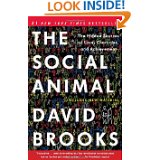
I guess it’s not the politics, but rather author David Brooks, who I should blame for my disappointment in his exploration of what he calls our ‘revolution in consciousness.’
Brooks attempts to meld fiction and science by explaining advances in neuroscience, genetics, psychology, sociology and economics through the real lives of two fictional characters. He follows them from conception to death explaining to us what’s really going on both consciously and sub-consciously.
Anyone who has read the current literature on neuro-psychology, behavioral economics or social theory will be familiar with the concepts, but Brooks does a nice job of translating the theories into real life.
Brooks, who is a New York Times columnist, write in a clear and linear style like may journalists, and his work is both believable and entertaining.
His biggest problem is his detour into politics. While Brooks is known for his conservative views, they are not the problem. My issue is with the method. The female character Brooks creates overcomes a poor childhood to excel in school and career. There is no inkling that she has slightest interest in politics but then suddenly at the height of her corporate career, she is named the head of a national presidential campaign, which lands her a job in the White House. Her husband takes a job in a Washington ‘think tank’ and becomes the mouthpiece for Brook’s views about governing, politics and the American political system.
Just in case you weren’t sure what he was doing, the charcater emphasizes that the only person who agrees with him is an ‘unnamed’ New York Times columnist.
The whole chapter seems contrived and out of place and detracts from the excellent work Brooks does to bring both his characters and scientific theory to life.
Despite this flaw Brooks work is very readable and is an easily understandable look at the science. Especially outstanding is his look at death and dying on the final pages.
So, you can skip chapters 19 and 20 if you don’t want to let politics ruin a good read, but certainly the other 20 chapters are well worth your time.
Dr. Weil Loses His Way
November 20, 2012
Dr. Andrew Weil’s latest book tour stopped in San Francisco last week. He’s on the road to promote his latest literary effort, a cookbook – True Food – based on recipes he cooks at home and are served in his emerging restaurant chain.
As part of his Weil Lifestyle campaign the book purports to establish a new healthy lifestyle and healthier recipes while rebutting the myth that ‘health food’ has to be bland or worse.
Dr. Weil was interviewed at Herbst Theater by fellow cookbook author Molly Katzen who spent an hour fawning of the integrative health guru while leaving it to the audience to ask controversial questions. Dr. Weil’s book offers recipes based on his own food pyramid which, while different from the hated FDA guide, leaves out very few foods that have led to the United States obesity epidemic.
In fact , Dr. Weil probably is a pretty good representative of the US population since he clearly doesn’t skimp on any meals. A doctor approaching obesity levels may not be the best spokesman for a healthy lifestyle.
Dr. Weil said he was also scouting sites for a new restaurant – one featuring good healthfood similar to the locations in Los Angeles, San Diego and Phoenix. The fact that the Bay Area has been a leader in the trend Dr. Weil promotes doesn’t seem to rate a mention even though places such as Cafe Gratitude, Planet Organic or Gather are way ahead of the good doctor.
Dr. Weil was asked about supplements and admitted that, aside from a daily multi-vitamin, most folks can get all the nutrition they need from a healthy diet. This does seem to question the range of supplements marketed and sold by Dr. Weil on his own website.
Dr. Weil also took a minute to chastise the assembled group for the failure of Proposition 37 the GMO labeling question of the November ballot. “How you could let that fail?” has asked.
No one rose to answer, but I would note there were several folks in the room who had worked very hard to get the proposal on the ballot and promote it’s passage. No doubt a few of them were a bit insulted that someone from Arizona, who did nothing to oppose the $50 million ad campaign put on by the Monsanto and Dow, would criticize their efforts.
Dr. Weil clearly does not oppose GMO food, preferring to wait for more evidence before branding it unhealthy. Of course, some folks would rather that it get proven healthy before allowing it in the food chain.
I’m afraid Dr. Weil has lost his way by promoting a food pyramid that would do little to improve the health of most Americans, selling suplements that he admits are mostly unnecessary and declining to oppose foods that have been shown to be unhealthy.
I’m sure it will do little to hurt his image or his income.



